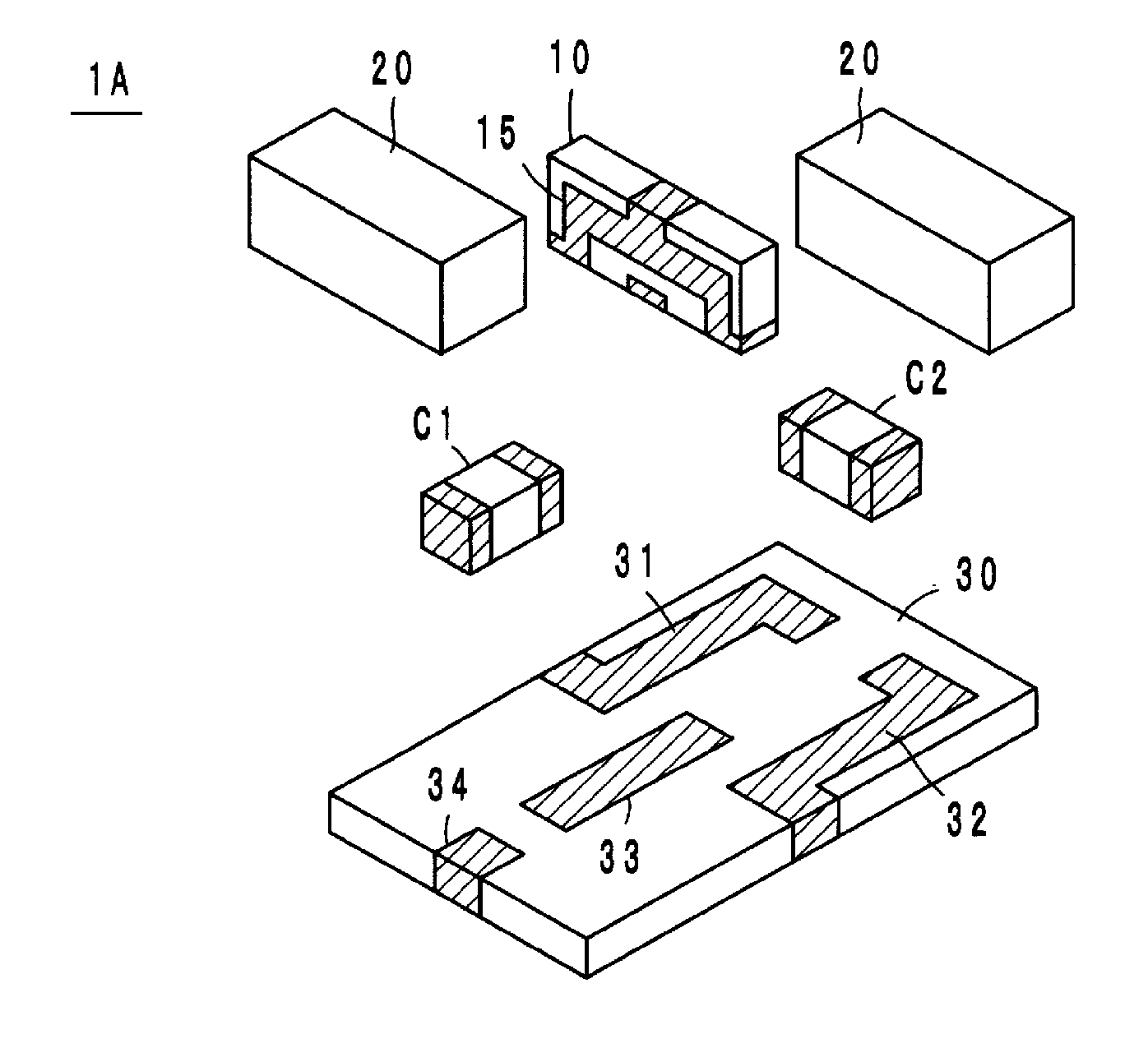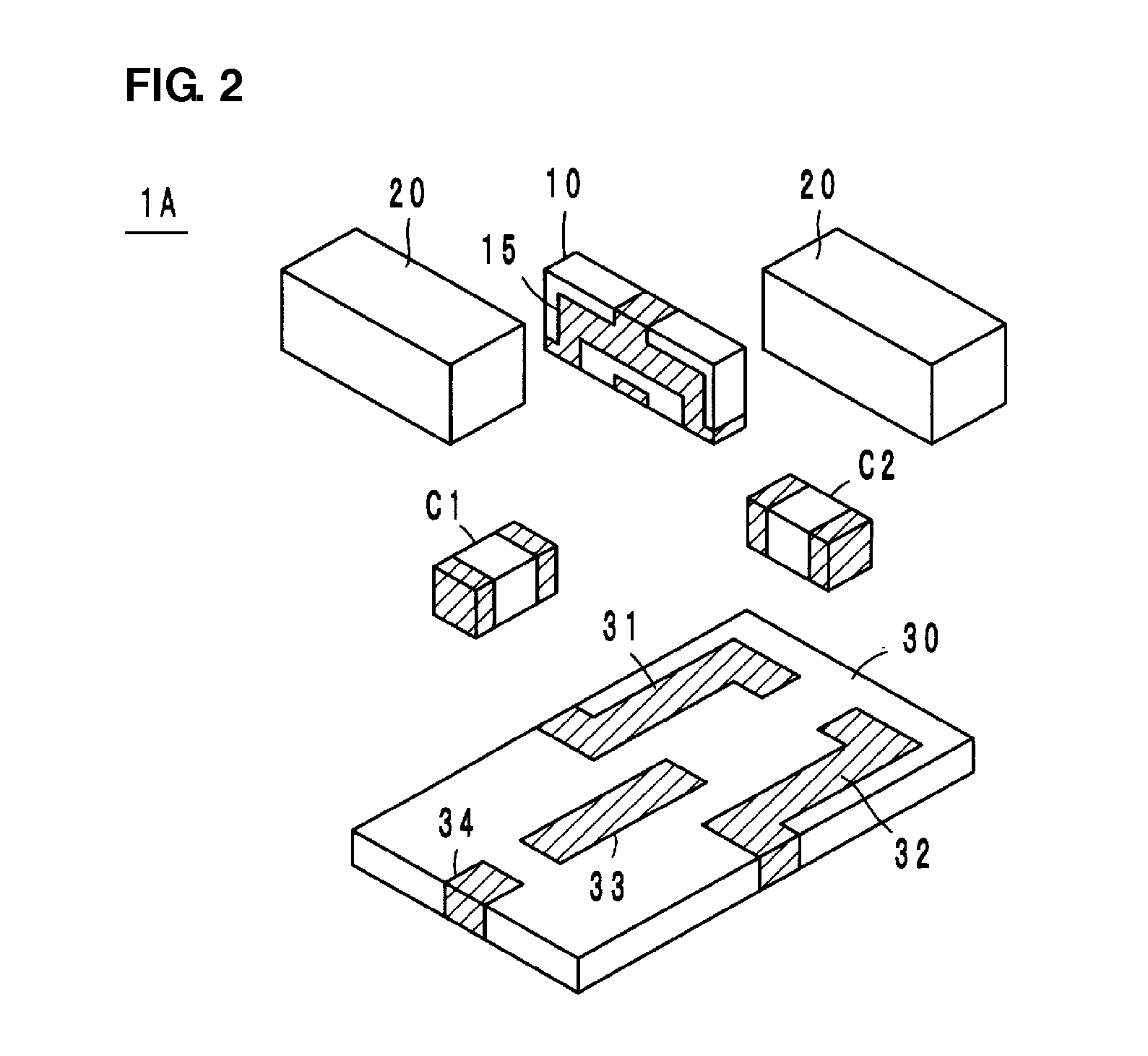Magnetic resonance type isolator
a type of isolator and magnetic resonance technology, applied in waveguide type devices, basic electric elements, electrical apparatus, etc., can solve the problems of incompatibility, increasing the density of the components of the communication device, and increasing the density of the communication device. , to achieve the effect of reducing the siz
- Summary
- Abstract
- Description
- Claims
- Application Information
AI Technical Summary
Benefits of technology
Problems solved by technology
Method used
Image
Examples
first preferred embodiment
[0033]A magnetic resonance type isolator 1A according to a first preferred embodiment will be described hereafter with reference to FIGS. 1 to 5D.
[0034]As illustrated in FIGS. 1 and 2, the magnetic resonance type isolator 1A according to the first preferred embodiment includes a ferrite 10, a connection conductor 15 including three ports P1, P2 and P3 and arranged on a first main surface 11 of the ferrite 10, a pair of permanent magnets 20 that apply a direct current magnetic field to the ferrite 10, a capacitor C1 that defines a first reactance element, a capacitor C2 that defines a second reactance element, and a mounting substrate 30.
[0035]The connection conductor 15 preferably is a thin film formed by, for example, deposition of a conductive metal or is a thick film formed by applying and baking a conductive paste. As illustrated in FIGS. 3A and 3B, a main line, which is arranged between the first port P1 and the second port P2 that face each other along a straight line, among t...
second preferred embodiment
[0044]A magnetic resonance type isolator 1B according to a second preferred embodiment will be described hereafter with reference to FIGS. 6 and 7A to 7D.
[0045]The magnetic resonance type isolator 1B according to the second preferred embodiment preferably has the same configuration as that of the first preferred embodiment except that an inductor L1 is preferably used as the second reactance element.
[0046]The operational advantages of the second preferred embodiment are basically the same as those of the first preferred embodiment. The input return loss, isolation, insertion loss and output return loss of the magnetic resonance type isolator 1B according to the second preferred embodiment are illustrated in FIGS. 7A, 7B, 7C and 7D, respectively. The inductance of the inductor L1 preferably is about 5.1 nH and the capacitance of the capacitor C1 preferably is about 3.5 pF, for example. The impedance of the input and output ports preferably is about 10Ω and the electrical characterist...
third preferred embodiment
[0047]A magnetic resonance type isolator 1C according to a third preferred embodiment will be described hereafter with reference to FIGS. 8 to 11D.
[0048]In the magnetic resonance type isolator 1C according to the third preferred embodiment, as illustrated in the equivalent circuit of FIG. 10, an inductor L2 is preferably used as the first reactance element, the capacitor C2 is preferably used as the second reactance element, and capacitors C3 and C4, which are connected to the ground, are respectively connected to the input terminal electrode 31 (first port P1) and the output terminal electrode 32 (second port P2). As illustrated in FIG. 9, the input terminal electrode 31, the output terminal electrode 32, the relay terminal electrode 33 and the ground terminal electrode 34 are provided on the mounting substrate 30. The rest of the configuration is preferably the same as that of the first preferred embodiment.
[0049]One end of the main line (first port P1) is connected to the input t...
PUM
 Login to View More
Login to View More Abstract
Description
Claims
Application Information
 Login to View More
Login to View More - R&D
- Intellectual Property
- Life Sciences
- Materials
- Tech Scout
- Unparalleled Data Quality
- Higher Quality Content
- 60% Fewer Hallucinations
Browse by: Latest US Patents, China's latest patents, Technical Efficacy Thesaurus, Application Domain, Technology Topic, Popular Technical Reports.
© 2025 PatSnap. All rights reserved.Legal|Privacy policy|Modern Slavery Act Transparency Statement|Sitemap|About US| Contact US: help@patsnap.com



